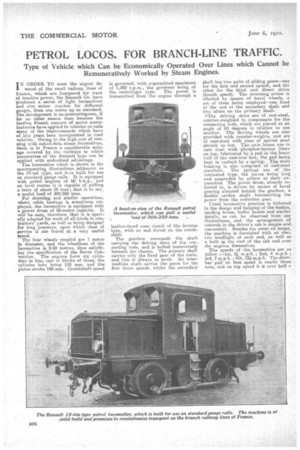PETROL LOCOS. FOR BRANCH-LINE TRAFFIC.
Page 10

Page 11

If you've noticed an error in this article please click here to report it so we can fix it.
Type of Vehicle which Can be Economically Operated Over Lines which Cannot be Remuneratively Worked by Steam Engines.
TN ORDER TO meet the urgent del. mend of the small railway lines of France, which are hampered for want of tractive power, the Renault Co. have produced a series of light locomotives and also motor coaches for different 'gauges, from one metre up to standard. The development is aininterestingione, if for no other reason than because the leading French concern of motor manufacturers have applied to vehicles on rails many of the improvements which have of late years been incorporated in road vehicles. Owing to the high cast of running with out-of-date steam locomotives, there is in France a considerable mileage covered by the railways to which locomotives of the Renault type can be applied with undoubted advantage.
The locomotive which is shown in the accompanying illustrations islknown as the 19-ton type, artkitAis built for use on standard gauge rails. It is equipped with petrol engines of 60 b.h.p., and on level routes it is capable of pulling a train of about 25 tons; that is to say, a useful load of 300-350 tons.
For shunting and similar operations, where cable haulage is sometimes employed, the locomotive is equipped with a power drum of 50-metre capacity. It will be seen, therefore, that it is specially adapted for work of all kinds in contractors yards, as well as being designee for long journeys, upon which class of ,pervioe it can travel at a very useful The four wheels coupled are 1 metre in diameter, and the wheelbase of the locomotive is 2.60 metres, thus satisfy.ing the specification of the Berne Convention. The engines have six cylinders in line, east in blocks of three, the cylinder bore being 110 mm, and the piston stroke 160 mm. Crankshaft speed
is governed, with alpermitted maximum of 1,200 r.p.m., the governor being of the centrifugal type. The power is transmitted from the engine through a leather-faced cone clutch of the inverse type, with no end thrust on the cranks6ft.
The gearbox surrounds the shaft carrying the driving discs of the connecting rods, and is bolted transversely beneath the chassis. The primary shaft carries only the fixed gear of the train, and this is always in mesh. An intermediate shaft-carries the gears for the first three speeds, whilst the secondary shaft has two pairs of sliding gears—ono for the first and second speeds, and the other for the third and direct. drive (fourth speed). The reversing action is effected by means of bevel wheels, a set of three being employed—one fixed at the end or the secondary shaft and two idlers on the primary shaft.
V.The driving discs are of cast4teel, counter-weighted to compensate for the connecting rods, which are placed at an angle of 90 degrees in relation to one another. The driving wheels -are also provided with counter-weights, and are of cast-steel with rims of special steel shrunk on hot. The axle boxes are in cast steel with phosphor-bronze liners on top, lubricated by a pad in the lower half of the cast-iron box, the pad being kept in contact by a spring. The main framing is also composed of cast-steel members. The springs are of the laminated type, the leaves being long and suspended by pillars at their extremities. The power drum, already referred to, is driven by means of bevel gearing situated behind the gearbox, a double cardan shaft transmitting the power from the reduction gear.
Usual locomotive practice is followed in the design and hanging of the brakes, sanding boxes, buffer beams and similar details, as can be observed from our illustrations, and the arrangement of controls in the driver's cab is simple and convenient. Besides the usual oil lamps, the machine is furnished with an electric headlight at each end, as well as a bulb ia the roof of the cab and over the engines themselves.
The speeds of the locomotive are as follow :-1st, 2Lm.p.h.; 2nd, 4 m.p.h.; 3rd, 7 m.p.h. ; 4th, 124. m.p.h. The drawbar .pull on first speed is nearly three tons, and on top speed it is over half P -on. The locomotive can be hitched behind a steam train and safely towed at speeds up to 37 m.p.h.
The Renault locomotives are made in sizes from 2 tons upwards, a special type running on compressed air. The series of motor coaches is designed up to powers of 90 la.p. and speeds up to 30 m.p.h. There can be little doubt in the minds of those who have studied the problem carefully that locomotives driven by petrol engines can be economically operated over the branch lines of railway systems where the traffic is sparse and ordinary steam locomotives are costly to run.
The system is not altogether an untried one, because it has been tested out with some success in such countries as America and Australia, where the dis
lances separating thinly populated areas
is often considerable. The conditions surrounding the operation of such vehicles in France are; however, totally dissimilar, and for this reasonthe experiment will be _watched with keen interest. When the results of theitrials. are made known, we hope to be in a position to give our readers additionalinformation.






























